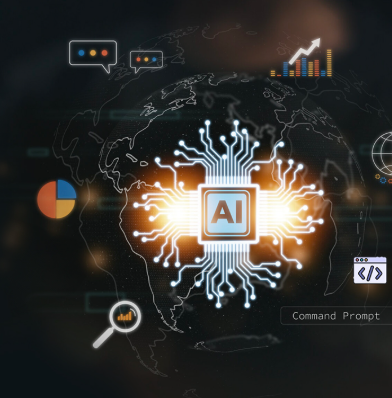How Artificial Intelligence Is Driving Sustainable Business Transformation
- 160 Views
- admin
- 06/12/2024
- Artificial Intelligence
In an era where sustainability is no longer optional, companies are actively seeking innovative ways to align their operations with environmental and social goals. One of the most promising solutions lies in artificial intelligence. As AI technology becomes more advanced and accessible, its applications are reshaping how businesses address sustainability challenges. From reducing waste and emissions to improving energy efficiency, AI is steadily becoming a key player in the movement toward a greener future.
Transforming Resource Use with AI
Efficient resource management is one of the most direct ways AI contributes to sustainability. By analyzing complex datasets, AI can help businesses optimize how they consume water, electricity, and raw materials. For instance, predictive tools can forecast resource demand, enabling companies to adjust their operations before overconsumption occurs. This proactive approach not only cuts down on waste but also improves supply chain reliability.
In agriculture, AI systems monitor soil conditions and weather patterns, helping farmers use water more efficiently and plan crop cycles more effectively. Manufacturers are also leveraging AI to streamline logistics and reduce excess inventory, which minimizes both waste and emissions across the production cycle.
Cutting Down Energy Waste with Smarter Systems
AI’s potential in energy management is substantial. It can monitor equipment performance and energy usage across facilities, then recommend optimal times for operation or maintenance to avoid peak energy rates. Additionally, AI is helping to integrate renewable energy sources into national grids by predicting output from wind or solar and adjusting distribution accordingly.
In homes and offices, smart appliances learn user habits and adjust settings to minimize energy consumption without sacrificing comfort. These intelligent systems demonstrate how small adjustments, powered by AI, can lead to substantial energy savings over time.
Aligning AI with Global Sustainability Objectives
Global goals like the United Nations’ Sustainable Development Goals (SDGs) offer a framework for social and environmental progress. AI technologies are proving valuable in tracking progress toward these goals. Whether it’s monitoring emissions, improving healthcare access, or analyzing inequality, AI helps organizations collect, interpret, and act on large volumes of data that inform policy and strategy.
AI also plays a critical role in education, public health, and city planning. From personalized learning tools that make education more inclusive to systems that support efficient transportation planning, the reach of AI into sustainable development is broad and impactful.
Reimagining Product Design Through Generative AI
Designing eco-friendly products is becoming easier with the help of generative AI. These tools simulate various design iterations, allowing businesses to select those that use fewer materials, are easier to recycle, or require less energy to produce. In architecture, for example, AI can suggest building designs that improve insulation and reduce the need for artificial lighting or climate control.
Similarly, in consumer goods, generative AI is assisting in creating sustainable packaging solutions and even forecasting fashion trends to reduce overproduction. These applications help companies innovate while staying aligned with environmental values.
Greener Supply Chains Powered by AI
Supply chains often have significant environmental footprints, but AI offers a solution through enhanced transparency and efficiency. With the ability to track supplier practices and analyze logistics routes, businesses can make smarter decisions that reduce emissions and ensure ethical sourcing.
AI also helps anticipate shifts in consumer demand, allowing companies to fine-tune production schedules and avoid unnecessary waste. In food supply chains, this technology enables better storage and distribution decisions, significantly reducing spoilage and loss.
Monitoring and Managing Environmental Footprints
To build a sustainable business, companies must first understand their impact on the planet. AI provides the tools to monitor environmental performance in real-time. By collecting data on emissions, waste, and resource usage, AI can highlight opportunities to reduce environmental harm and guide long-term strategy.
This includes optimizing facility operations, improving waste management through automated sorting systems, and tracking water consumption in high-use industries. These insights allow for more informed decisions that benefit both the environment and the company’s bottom line.
Accelerating Green Innovation
AI is supporting a wide range of green initiatives. In urban areas, AI is helping to develop smart city infrastructure that reduces traffic congestion, improves public transit, and supports efficient waste collection. These technologies contribute to cleaner air and better quality of life for city dwellers.
In agriculture, AI tools offer precision farming techniques that cut down on water, fertilizer, and pesticide usage. Meanwhile, in product development, AI aids in designing items that last longer, use sustainable materials, and are easier to recycle—important steps toward a circular economy.
AI also enhances corporate accountability by helping organizations track progress on sustainability goals. With clear performance metrics, companies can adjust their strategies and report transparently to stakeholders, reinforcing their commitment to sustainability.
Conclusion
Artificial intelligence is proving to be a powerful catalyst for sustainable change. By making operations more efficient, reducing waste, and supporting eco-friendly innovation, AI is helping businesses align with modern environmental and social expectations. As the technology continues to evolve, its influence will only grow stronger—empowering organizations not just to meet sustainability targets, but to lead the way toward a more responsible and resilient future.
Recent Posts
- How AI is Revolutionizing Architectural Design: A Look at Tools, Trends, and the Future
- Streamlining Cyber Risk Assessments Through Automation
- Understanding the Difference Between Blockchain and Distributed Ledger Technology
- Is Bitcoin Mining Still a Viable Venture in 2025?
- Exploring AI: Unveiling Possibilities, Challenges, and Future Implications

